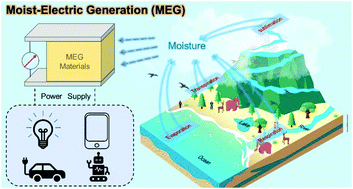Moist-electric generation
Abstract
The exploration of green and clean energy could solve the increasingly serious problems of environmental pollution and energy crisis on the Earth. Moist air is ubiquitous around the world, which particulalrly has huge chemical potential energy because of the gaseous state of the water molecules. Recently, our group demonstrated direct electricity generation by the interactions between moisture and various functional materials, which opened a window for the utilization of moisture power. This has led to an upsurge in studies on moist-electric generation (MEG). In this minireview, we provide a brief and systematic discussion on MEG from its working mechanism to practical applications and, the recent progress in advanced materials. The current challenges and the potential trends in MEG are also outlined to guide the design and synthesis of high-performance MEG devices in the future.

- This article is part of the themed collections: 2019 Nanoscale HOT Article Collection and Recent Review Articles


 Please wait while we load your content...
Please wait while we load your content...